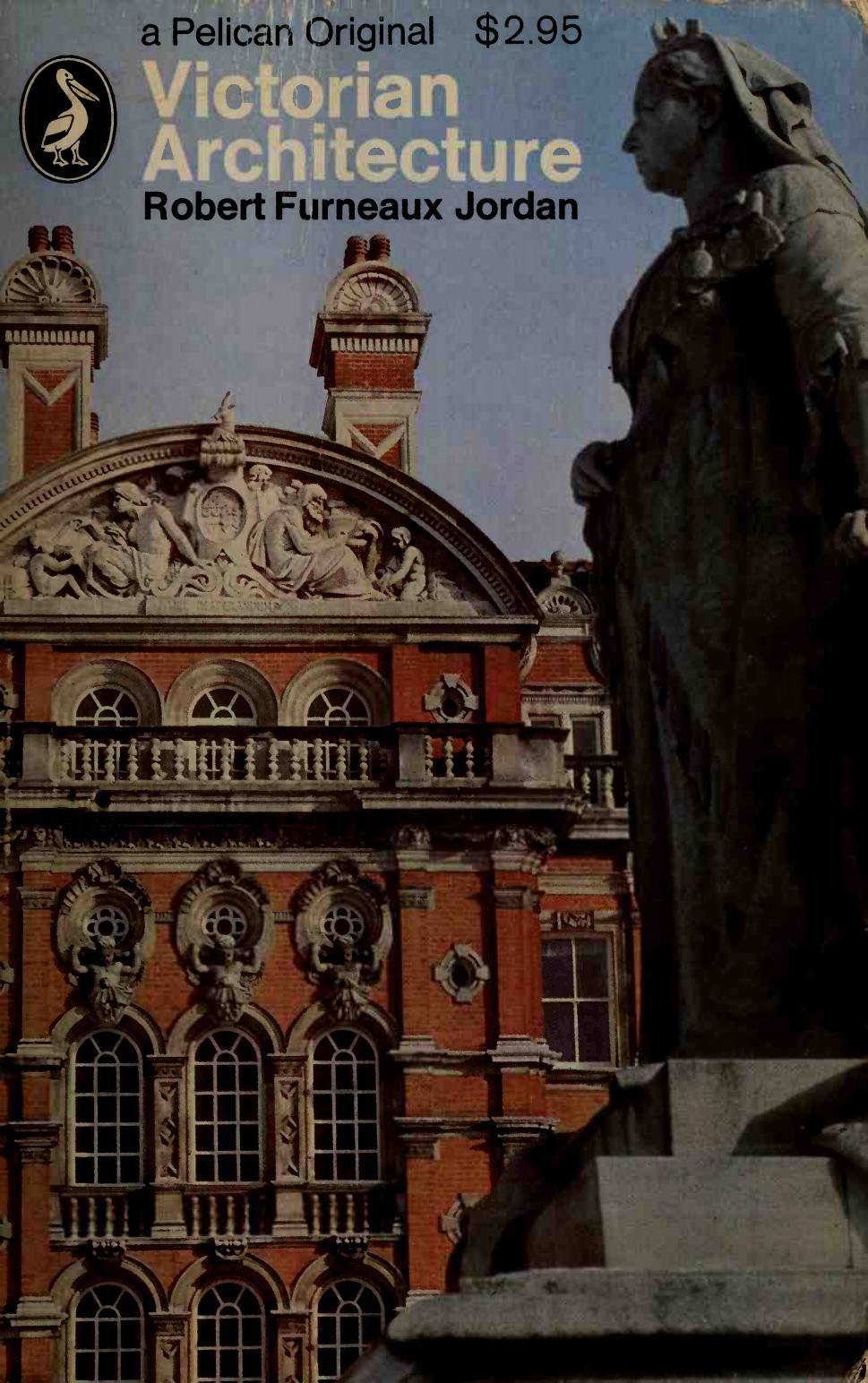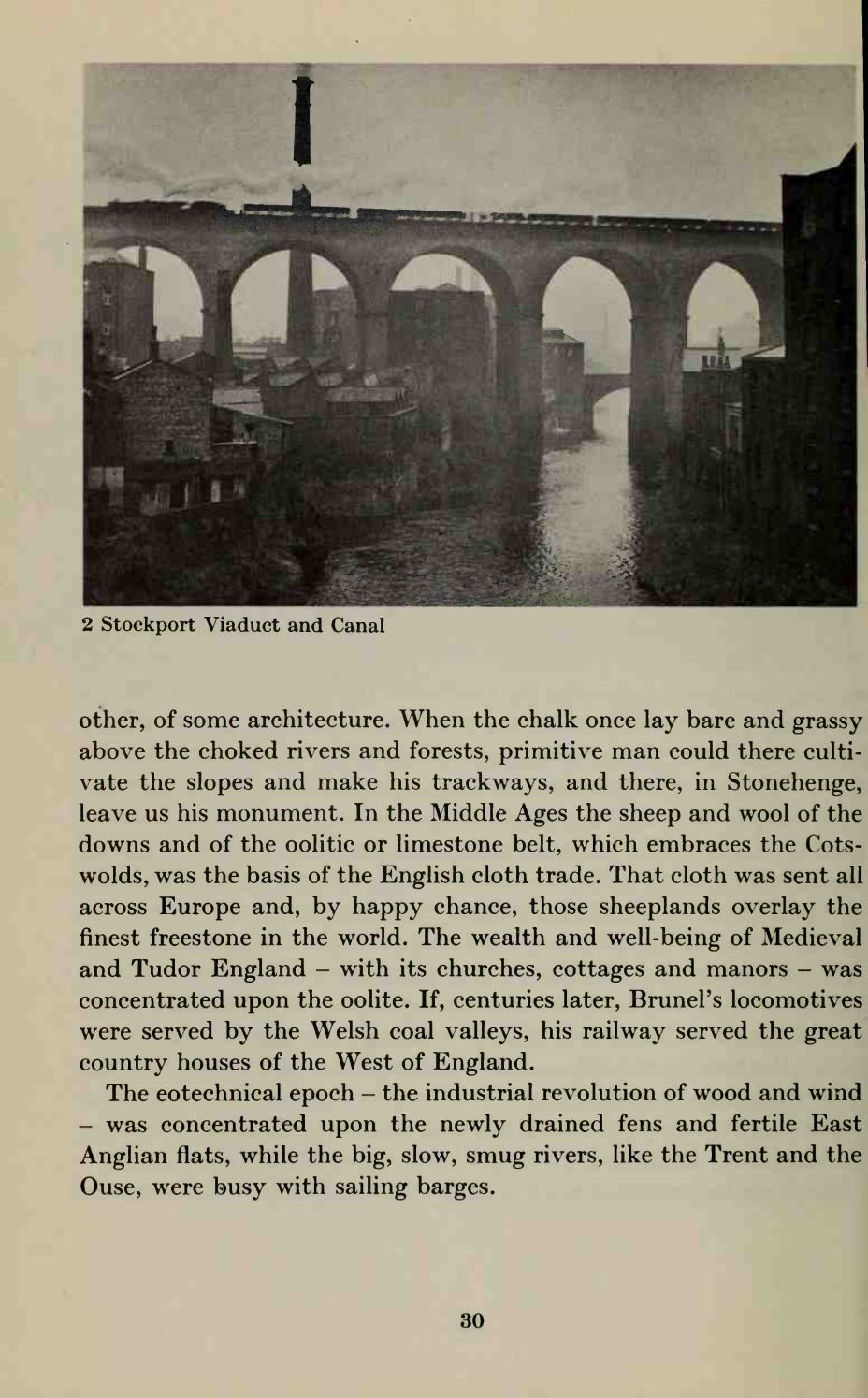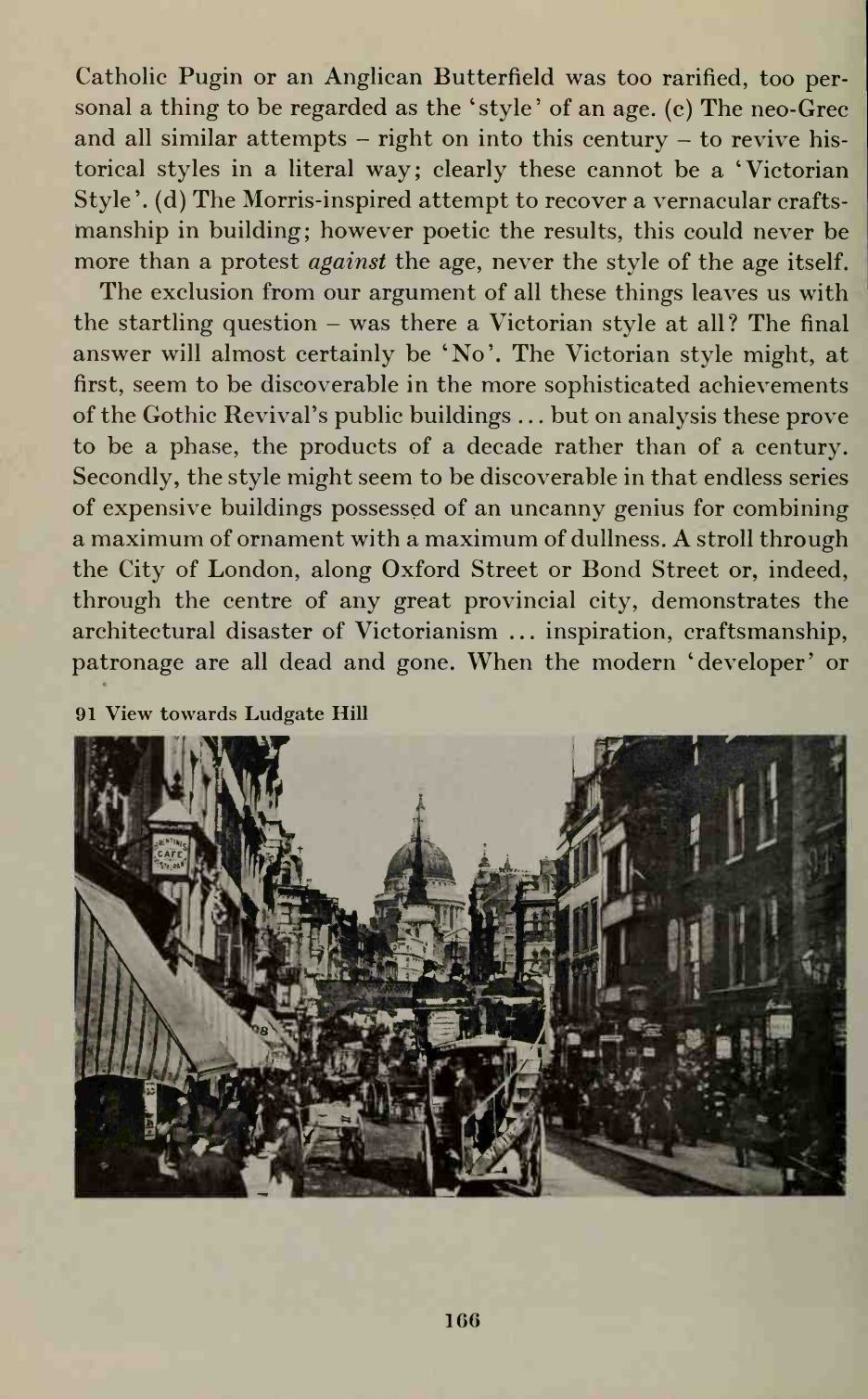|
|
Jordan R. F. Victorian Architecture. — Harmondsworth, 1966  Victorian Architecture / Robert Furneaux Jordan. — Harmondsworth : Penguin Books Ltd, 1966. — 278 p., ill.
We are still in the Victorian age – the iron train sheds, the smoke-blackened monuments of the North, the shades of Gothic in churches, palaces, and suburban streets, the grim terraces of mining towns ... these form a backdrop our world. In Victorian Architecture are expressed the triumphs, contradiction and failures of Victorian society. This book encourages us to understand what as we look around, we cannot ignore.
Robert Furneaux Jordan was born in 1905 and educated at King Edward’s School, Birmingham, and the Birmingham School of Art. He became an Associate of the R.I.B.A. and received his A.A. Diploma in 1928 from The Architectural Association school in London. He lectured on design and architectural history there from 1934 to 1963, while at the same time in general practice as an architect. In 1948 he became the school’s Principal, leaving in 1951 for the position of Architectural Correspondent to the Observer, which he held for the next ten years. After this he was Hoffmann-Wood Professor of Architecture in the University of Leeds, 1961–2, and visiting Professor of Architecture in the University of Syracuse, U.S.A.
Robert Jordan has been a frequent broadcaster on the B.B.C. and has contributed to architectural journals. He is the author of The English House (1959), and European Architecture (1961). He has lived mainly in London but is now married and lives in Wiltshire, with interests ranging from the field of ideas and cultures to racial freedom and liberalism. He has also written a successful detective story under a nom de plume.
Preface
We live in an age not of great art but of great scholarship. Everything is collected, dated and catalogued. So far as Victorian architecture is concerned we have now passed from the esoteric to the popular. To be interested is no longer to be considered odd. We all owe an incalculable debt to the late Mr Goodhart-Rendel who was a pioneer of Victorian research at a time when the subject was not only esoteric but beyond the pale. Kenneth Clark’s Gothic Revival, published in 1928, opened the first window upon an episode in the history of taste that was then still despised. Professor Pevsner’s Pioneers of the Modern Movement was a classic from the moment that it appeared in 1936 – the first attempt to build a bridge between the Victorian Age and modern architecture. If Professor Russell Hitchcock’s Architecture of the Nineteenth and Twentieth Centuries (1958) shows too little understanding of the social and technical roots of English Victorianism, it remains a most comprehensive work of reference. To all these, and to innumerable others, any writer on Victorian architecture must acknowledge a debt. At the same time my object is quite different from theirs.
The years of cataloguing and annotating are over. Comprehension must now replace erudition. The ‘how’ and the ‘where’ have been dealt with, not so the ‘why’. Why are we interested in Victorian architecture? Why does Victorian architecture – an extraordinary phenomenon anyway – exist at all? In an attempt to answer these two questions I have written this book.
The first question – Why are we interested in Victorian architecture? – is the easier of the two, even if the answer involves a further problem – Why do fashions in taste move forward in time? It was not, after all, until the old Regent Street was demolished in 1928 that the Regency was ‘discovered’; and not until television had brought Mr Betjeman’s poems to a mass audience – years after they were written – that ordinary people became aware, rather suddenly, that every day they walked in Victorian streets. Somehow or other of course – with or without Mr Betjeman – Victorian architecture would, like that of the Regency, have been rediscovered. William Morris’s Society for the Protection of Ancient Buildings, founded in 1878, hardly ventured to protect anything as ‘late’ as the eighteenth century; for W. S. Gilbert ‘art stopped short at the cultivated court of the Empress Josephine’. Then, a generation ago, we had the Georgian Group, and now the Victorian Society. The neo-Georgians will soon be upon us!
But that always happens – first to forget and then to rediscover – with much misunderstanding – the art of one’s grandparents. The Victorians themselves, for instance, idealized Georgian England, although they got almost everything wrong. Since they were romantic, industrial and liberal, in self-defence they had to repudiate an era that had been classic, agricultural and aristocratic, to repudiate Georgian elegance, and to discover and idealize other, and often purely imaginary, values.
In a hundred Victorian novels and paintings the Georgian world was idealized, romanticized, sentimentalized ... but of course it was not the Georgian world at all. It was a Victorian dream. The filth, cruelty, crime, stench and snobbery of the eighteenth century were forgotten. Together with the elegance – which really was a Georgian asset – they were replaced by a foolish picture of periwigs, snowclad Christmases, spanking coaches, benevolent squires, highwaymen, Trafalgar, Waterloo and old gabled streets. That the powdered wigs had usually been lice-ridden and their wearers pox-ridden, that the Victory had several whores on board, that the troops at Waterloo were the scum of the earth, that Dick Turpin was a nasty sadist, that it seldom snowed at Christmas – twice in Dickens’s lifetime – and that the gabled streets were not Georgian at all, were among the things the Victorians chose not to know. That Georgian houses were beautiful – the one thing in the dream that might have been true – was ignored. Dickens could dismiss Bath, with all its Augustan beauty, as ‘an old rookery’. But then Dickens was an inveterate Victorian: his picture of times present – gaols, workhouses, schools – was devastating; his picture of times past was beneath contempt.
This too, then, would seem to be a law: that each age in repudiating its forerunner, both idealizes and distorts. We are no better. In reversing Victorian values, and idealizing the Victorian world, we have distorted the picture – have done to the Victorians what they once did to the Georgians. The Victorians lived in a world of Georgian towns and villages, and thought it merely dull. So with us: the whole backcloth of our lives – rural and urban – is still mainly Victorian. Most of us, however, see only those bits and pieces – the little old shopfront or the country rectory – which live up to our picture of the good old days’. Significantly a much favoured author in air-raid shelters was Trollope; whereas, in fact, Victorian realpolitik had paved the way for the bombs.
Nevertheless, for all the bugs, beetles and drains, that quiet world of Barchester or Cranford, that earnest world of Tractarian parsons and Oxford common-rooms, that world of Hardy’s peasants buried deep in English shires, did really exist. Of course it did. But it was not very important. By and large Victorian England was a tremendously virile and very terrible affair. If we strip away the gadgets and fashions, Victorian England was not unlike the United States today. There was the same unblinking worship of independence and of hard cash; there was the same belief in institutions – patriotism, democracy, individualism, organized religion, philanthropy, sexual morality, the family, capitalism and Progress; the same excitement and movement; the same overwhelming self-confidence, with its concomitant – a novel and adventurous architecture. And, at the core, was the same tiny abscess – the nagging guilt as to the inherent contradiction between the morality and the system.
For anyone who wishes to study the Victorian Age it was, like our own, complicated but very rich in records. Whether in prose or verse, painting or architecture, or even photography, the Victorians have left us a most detailed picture of themselves. In all spheres of life Mr G.M. Young’s Early Victorian England (1934) was able to give us one af the most complete pictures of a past epoch that one could wish for. For all that we still go on picking out the pieces of the jig-saw that suit us. The lady of today – dreaming of some age of lavender-scented charm – hangs up a sampler. She forgets the little girl, sore-eyed and constipated, stitching beneath the hard correction of the rod. That lady sets her waxed fruit, her Berlin woolwork, her Victoriana, as splashes of colour against the white wall of her cottage parlour. She forgets the crowded, darkened suburban drawing-room where these things were born, forgets the creatures who dusted them so long ago.
And if in these pages I try to evoke just a little of the vigour, the self-assurance, the sheer artistry of, say, Waterhouse’s High Victorian architecture in Manchester, we must never forget that the main contribution of the Victorian Age to architecture is the Slum. If the Town Hall in Manchester is really rather superb, there was also ... the rest of Manchester.
In our admiration and wonder at the grand skyline – the towers of South Kensington or the pinnacles of Whitehall Court – we must remember the other side of the medal. There were the slums; there were also the vast Saharas of suburban roads, commonplace, speculative or merely squalid – occasionally pretentious. We can still take a bus ride – north, south, east or west – from the middle of London, out through all the villages that London has devoured, out and out until we come to the end, to the commuters’ housing estates of our own time.
The Londoner of today – despite our own building energy – still lives in a place mainly Victorian. At the core are the two medieval cities, each set in the tangle of medieval lanes that still surround the Abbey and St Paul’s. Then, beyond that – the next ring round the heart of the tree trunk – is just a little of the elegant order of the Georgian era, the squares of Bloomsbury or Mayfair. All along the rim of this Georgian London – and the stile at the top of Portland Place was the end of the Town – they built the iron-roofed railway stations. Beyond that, out to Barnet or Epping Forest in the north, to Kingston in the south, to Blackheath in the east, and to Staines or even Windsor in the west – with here and there an oasis of some old village green or common – was Chaos and Old Night.
In that impenetrable forest of houses, railways and canal cuttings, cemeteries, gasworks and gas lamps, Victorian man was bred, and gave birth to our own grandparents. The empire-builders, the little bank clerks, the gin-sodden navvies, the respectable wife-murderers, the pious matrons, the bohemian rebels ... in that great compost of bricks and mortar they built for themselves an architecture ... of sorts.
The architecture of the Victorian Age tells us more about the men who made it than does any other architecture in history. It made such very definite statements about life; it was all so self-assured and vulgar, that it never leaves us in doubt. It never diluted itself – as has our architecture – with inhibitions about style or taste. The Victorian architect knew what he wanted to do and, good or bad, he did it.
Victorian architecture fascinates us, but we must beware. We see it today either as a complete whole, or else surrounded by buildings of our own time. We also see much of it with a hundred years of grime on it. In fact it was a kind of kaleidoscope – as much being demolished as was built – and always against the backcloth of an earlier time. It has been remarked, and Canaletto painted it for us, that Inigo Jones’s Banqueting House in Whitehall was once uncompromisingly modern. It out-topped the little brick and timber houses of medieval Westminster. We see it now as an item in a modern street; the seventeenth century saw it as aggressively high and large, white against a clean sky. So we must try to see Victorian architecture. When the Queen went to the Abbey to be crowned, the new Houses of Parliament, just across the road, were hardly begun; Carlton House Terrace was gleaning white, and very few of the public offices in Whitehall existed. When the Queen died sixty-four years later, the Imperial Institute was all silver laced with gold, and the town was all round it. Holborn Bars is now a medieval relic for tourists; there was much of that kind if thing, unregarded, in the London of Barry and Butterfield. And the villages all around – Chelsea, Kensington, Battersea, Hampstead and the rest – were still only villages. Farther afield, if the great engines in Sheffield or Birmingham had begun to turn, it was still the cattle markets and the big sailing barges on the Trent or the Ouse that mattered most.
‘When the cathedrals were white’ is a phrase of Le Corbusier’s. Those Victorian hotels, stations and town-halls and museums were once also white and red and raw. With coal fires burning in every room the soot soon fell, but even so there must have been times when the huge Gothic Revival piles reared themselves garishly into the sky while, quite near, were cottages and fields. We think we know what the St Pancras Hotel is like – and that is startling enough. To see it brand new, with the cattle and the hay wains, as well as the cabs, in the muddy, foggy road outside, needs a more conscious effort of the imagination.
There is not much difficulty, therefore, in finding an answer to my first question: why are we interested in Victorian architecture? Being so unlike any other architecture that there ever was, it is fascinating in itself. It is far enough from us to belong to a world utterly unlike our own. It is near enough to us to be all round us every day, and also to be, as it were, the womb from which we have come.
My other question – why did Victorian architecture exist at all? – is more difficult to answer. Of course a virile nation, with a rising population, had to build somehow and somewhere, but why in that particular form – alternately so beautiful and so grotesque? The answer is complex. I hope that this book – rather than adding further to those invaluable lists of names and dates – will give the reader at least a tentative answer.
R. Furneaux Jordan
Ross Bar, Co. Cork, 1964
University of Syracuse, N.Y., 1964–5
Burcombe, Wiltshire, 1965
Contents
List of Illustrations 9
Preface 15
Acknowledgements 21
1 The Nature of an Industrial Revolution 25
2 The Nature of a Romantic Movement 42
3 The Gothic Revival: Phase One 58
4 The Gothic Revival: Phase Two 77
5 The Crystal Palace and the Engineers 110
6 High Victorianism 136
7 Ruskin and Morris 170
8 Arts and Crafts, and Art Nouveau 185
9 The House 206
10 Modernity is Born 240
Bibliography 263
Index 269
Sample pages 
Download link (pdf, yandexdisk; 37,2 MB).
Все авторские права на данный материал сохраняются за правообладателем. Электронная версия публикуется исключительно для использования в информационных, научных, учебных или культурных целях. Любое коммерческое использование запрещено. В случае возникновения вопросов в сфере авторских прав пишите по адресу 42@tehne.com.
12 ноября 2020, 14:58
0 комментариев
|
Партнёры
|






Комментарии
Добавить комментарий